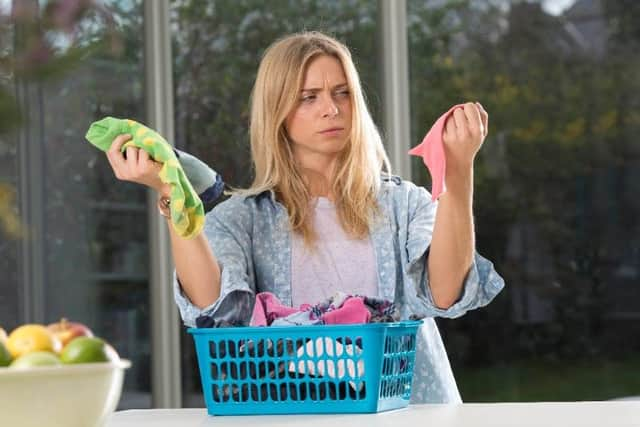VIDEO: Scientists unravel the mystery of why socks go missing


Created by Psychologist Dr Simon Moore and leading statistician Dr Geoff Ellis, the algorithm, titled the ‘sock loss index’ is: (L(p x f)+C(t x s))-(P x A)
It takes a variety of sock-related factors into account -- including volume of laundry, number of people in the household, type of wash (darks, whites) and amount of socks washed.
Advertisement
Hide AdAdvertisement
Hide AdDegree of attention to the wash - such as checking pockets and unrolling socks - is also part of the complex calculation, along with how much someone loves or hates doing a wash.


The study of 2,000 people, commissioned by Samsung to launch its new AddWash washing machine, found Brits lose 84 million socks every month - costing the nation an estimated £2 billion a year.
Melanie Rolfe, Head of Marketing - AddWash™ & Home Appliances at Samsung Electronics UK and Ireland said: “We believe this new study has finally solved the age old mystery of the missing socks.
“At Samsung we are changing the way we do laundry with the new AddWash™ machine.
Advertisement
Hide AdAdvertisement
Hide Ad“No longer will we load the machine with trepidation as we worry whether pairs will be separated forever.


“Now we can add those loose socks, and indeed any other item of clothing you forgot, in mid-wash to ensure everything stays together.”
The survey found socks are lost for a host of reasons including the way washing loads are divided-up by colour and temperature of the wash -- and the number of socks in each cycle.
Through interviews, researchers were able to pinpoint the common causes of sock loss - including items falling behind radiators or under furniture without anyone realising.
Advertisement
Hide AdAdvertisement
Hide AdStray items being added to the wrong coloured wash and becoming separated from its matching sock also featured.
Socks not being secured to a washing line securely causing them to fall off and blow away was identified too, along with carelessly pairing them up post wash.
Of those surveyed, on average 1.3 socks are lost each month - about 15 every year.
With the average Brit living to 81, according to ONS figures, this is a loss of 1,264 socks per person during their lifetime -- costing them an estimated £2,528 each.
Advertisement
Hide AdAdvertisement
Hide AdColoured socks make up the majority of missing socks (55%), compared to other types (including white and patterned items) which make up the remainder.
The average household does 2.45 washes per week which amounts to 127.4 washes per year.
People in the Midlands suffer the highest incidence of sock loss, admitting that 1.64 socks go missing each month - almost 20 socks a year.
More than a sixth of those surveyed said doing the laundry was a waste of their valuable time.
Advertisement
Hide AdAdvertisement
Hide AdMen said they do two washes each week and women do slightly more, carrying out three loads over the same period.
About a fifth said one of their biggest anxieties about washing is colours running.
Indeed seven in 10 women said they find doing a wash stressful - compared to three in five men.
THE SOCK LOSS FORMULA:
Sock loss index= (L+C)-(P x A)
The higher the figure, the higher the likelihood of losing socks. For the truly diligent, this formula can also be adapted to work out the probability of losing a sock in a single week by using a calibrated version using statistical modelling software which adds constants as follows:
Prob= 0.38+(0.005 x L)+(0.0012 x C)-(0.0159 x P x A)
Where:
L = Laundry size
Advertisement
Hide AdAdvertisement
Hide AdCalculated by multiplying the number of people in the household (p) with the frequency of washes in a week (f)
C = Washing complexity
Calculated by adding how many types of wash (t) households do in a week (darks + whites) and multiplying that by the number of socks washed in a week (s)
P = The positivity towards doing laundry
Measured on a scale of 1 to 5 with 1 being ‘Strongly dislike doing clothes washing’ to 5 which represents ‘Strongly enjoy doing clothes washing’
A = Degree of Attention
Which is the sum how many of these things you do at the start of each wash check pockets, unroll sleeves, turn clothes the right way and unrolling socks